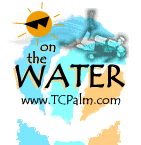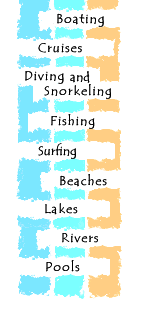Between St. Lucie
Inlet and the tip of Cape Canaveral there is a vast sandy ocean
bottom with only a small percentage of natural or artificial reef.
For years, a lot of fishermen have dreamed of having their own
private fishing hole. A spot where they can reel in bragging-size
catches on demand.
Sounds like fun, doesn't it?
Wouldn't it be neat to have a spot that only you knew about, that
you could run to out of St. Lucie or Fort Pierce Inlet.
After a glance or two over your shoulder to make certain no one
was watching to learn the location of your secret spot, you drop
down a bait and start reeling in big grouper and snapper!
Fishermen even have a name for such a private fishing spot -
"Honey hole.
Believe it or not, this fishing fantasy is becoming a reality in
the Gulf of Mexico off the Florida Panhandle.
If you had a piece of swiss cheese in the shape of a tennis ball
and cut it in half, you would have the shape and appearance of this
fishing dream.
It is called a Reef Ball. But it is slightly bigger - make that
much bigger - than a tennis ball. A real-life Reef Ball is made of
concrete and weighs 4,000 pounds. It is 4 feet high.
You might call the Reef Ball an underwater condo for fish,
especially grouper and snapper.
After the Reef Ball is in the water awhile, marine organisms
begin to grow, small fish move in, then larger fish ... and finally
you, the sponsor of this private spot, arrives at the surface with
rod and reel in hand.
"So far we have put down a little over 40,000 Reef Balls, about
10,000 of them in Florida State waters, said Todd Barber of
Sarasota.
Todd and his father, Jerry, came up with the idea for the Reef
Ball eight years ago while on a skin diving vacation in the Cayman
Islands.
"I had visited the Cayman Islands as a kid and was amazed at the
number and variety of fish on the reefs, Todd said. "When I came
back as an adult, I was amazed again ... at how the number of fish
on the reefs had declined.
According to Todd, six years of research and development went
into perfecting the Reef Ball.
"The whole idea was to make something simple, inexpensive but
most importantly, something which helped develop a fish population,
Todd said.
The Reef Ball has proven to be more effective than its creators
imagined; it attracts grouper, snapper and a variety of bottom fish.
Bill Lindberg, associate professor at the University of Florida's
Department of Fisheries, says an artificial reef can boost fish
population by about 8 percent.
If a reef site is over-fished, it can result in a decrease fish
population.
This is what makes the Reef Ball special. If the specific
location of a Reef Ball is known to only one or two fishermen, they
are going to protect their "Honey Hole and keep the site secret. The
overall effect of thousands of Reef Balls, is a gradual build-up of
bottom fish populations. As individuals concentrate on their own
private fishing spot, it takes away angling pressure from other reef
areas.
The one-time cost of a Reef Ball to a sponsor is $300. There are
now 15 contractors making Reef Balls for the non-profit Reef Ball
Development Group based in Sarasota. Todd Barber is head of Reef
Ball Development.
"These things work. We now have Reef Balls offshore of every
Panhandle County. On the Florida east coast, we have them in Dade
and croward Counties, Palm Beach County and in the Cape Canaveral
area, Todd said.
Be nice if Martin County tried a few Reef Balls in our area. They
work best in 60 feet of water or more.
One of Todd Barber's goals is to build the largest artificial
reef in the world - one mile long - off Pensacola. He and his father
want to give the reef to the State of Florida on behalf of smallboat
fishermen.
Dale Minnick and Bill Carson are licensed to build Reef Balls in
the Pensacola area. They are seeking state and federal permission to
use 114 square miles, 14 miles offshore in the Gulf, as an area to
place Reef Balls.
"For $300, we build and deploy a Reef Ball and give you - the
sponsor - the GPS numbers to your own private fishing spot, said
Bill Carson. GPS numbers pinpoint a spot via satellite.
Todd Barber says he has been contacted by a spokesman for the
Philippine Government to discuss placing possibly one million Reef
Balls to help restore fishing in the islands.
Not everyone is thrilled at the prospect of fishermen with
private "Honey Holes in the Atlantic Ocean or Gulf of Mexico. Some
fishermen and scientists think the idea is outrageous, giving up
public waters for private use.
What a lot of people do not realize is, many fishermen have been
dumping things - cement blocks, 55-gallon drums, old refrigerators,
etc. - to build their own reefs for decades.
Artificial fishing reefs are here to stay. In my view, the Reef
Ball might be the fishing development of the 21st Century ... it
arrived a couple of years early.
<=Back




